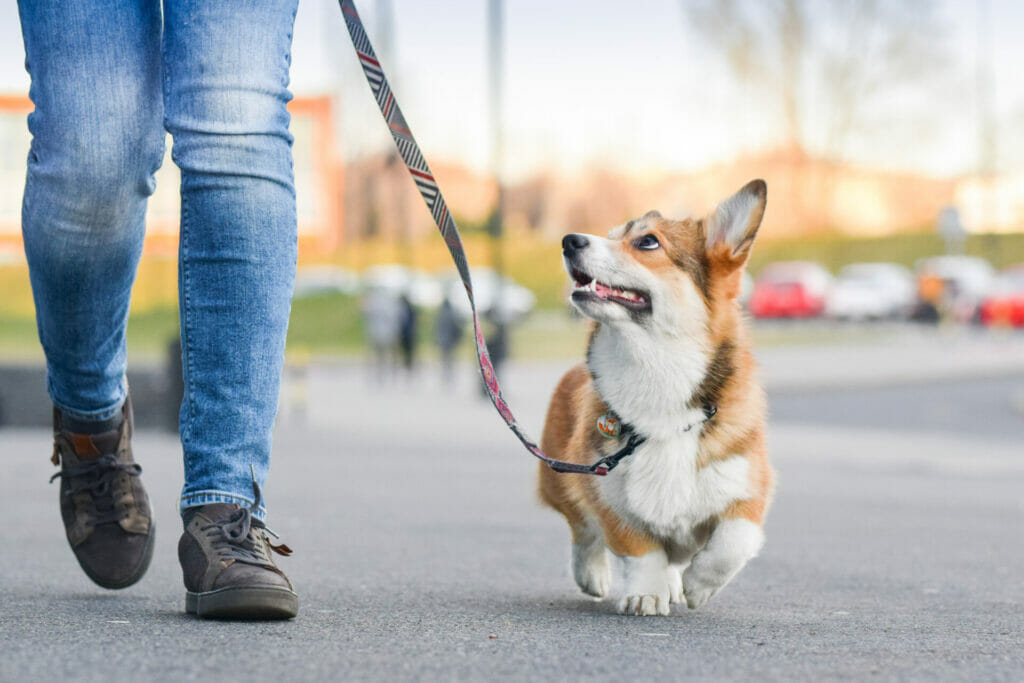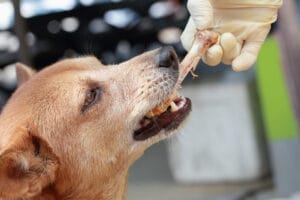Teaching your pup to walk nicely on a leash is not an easy feat! Trust us, we’ve been there! The behavior of your dog walking with a loose leash will take some time to achieve. We can’t blame them for being excited when they go out for a walk! Your dog is naturally going to be very interested in all the new sniffs, sights, and sounds they are experiencing outside. Their walk time is one of the only chances they have in their day to explore the outdoors! This means that distraction levels are higher, causing them to pay more attention to their environment and lose interest in being near you. This usually causes frustration for pet parents: it’s overwhelming to be yanked in so many different directions! Some people have so much difficulty walking their dog on a leash that they just stop walking their dog altogether. We want walking your dog to be fun, so here are some tips, tricks, and games you can play with your dog to help reinforce the behavior of them wanting to walk next to you.
Puppies
If you have a puppy, they want to be near you as much as possible when walking. Take advantage of this! Puppies need more confidence in new environments and will want to stay close to you because they seek comfort. Reward them as much as possible for sticking by you! As puppies develop, there will come the point where they are super curious and more interested in their surrounding environment, so the window of opportunity to develop solid loose-leash walking skills with puppies is limited. This doesn’t mean you won’t be able to change the behavior once they are older, but you might find that more training time will be required.
Treats and rewards
It’s always a good idea to bring treats or other high-value items with you on every walk! Some dogs are not interested in taking treats when they are outside. If that is the case, you might want to motivate them by upping the value of the food you’re bringing with you to see if that helps capture their attention. Otherwise, you could try and bring a toy or ball that they love. Sometimes the regular treats they receive inside the home without any distractions are not interesting enough once in the presence of more distractions.
*If your dog won’t respond to any treats or toys when outside, in addition to exhibiting fearful body language like a tucked tail, freezing, or shivering/shaking, we recommend connecting with a certified positive reinforcement dog trainer to analyze and address any potential fear-related issues your dog may be experiencing outdoors.

The 1 2 3 Game
Have your puppy start walking with you around the house on their leash. If you notice your puppy walking next to you with no tension in the lead for 1 2 3 steps in a row, give your marker the word “yes,” followed by the delivery of a treat. You want to feed the treat while walking instead of stopping and then giving the treat, as this reinforces walking next to you instead of accidentally reinforcing the behavior of “stopping.” Once you notice your puppy catching on to walking next to you without any tension in the lead, you can increase the number of steps needed before delivering the treat.
Chase me
This game teaches your dog to focus on you while walking and entices them to pay attention to you because you’re engaging with them on the walk. You can start in your house or yard with your dog on a leash and with some yummy treats in your pocket. I would also use a longer lead for this game (10-12ft). Take a few steps forward; if your dog is paying attention to you and keeping the leash loose, use a marker word like “yes” and immediately jog backward for several steps. When your dog turns toward you and follows you backward, reward it with a treat. You can repeat and mix up the number of steps forward and backward as your dog learns to keep the leash loose at all times.
Frozen statue
If you find that your dog is pulling you and there is a lot of tension in the leash, you should FREEZE in your tracks, don’t continue to walk, and wait until your dog returns to your side. Once your dog returns to your side, you can continue the walk and reward your dog for walking next to you. Not continuing to walk until your dog is next to you helps them slowly understand that we won’t keep moving until they are near you and there is no tension in the leash.

Set yourself (and your dog) up for success!
We suggest practicing these games and the behavior of loose leash walking inside your home where there are few distractions before taking it outside. This will help your dog learn what behavior you’re looking for, as they are more capable of learning when in a more calm mindset. When you’re ready to take the training outside, please do not expect your dog to be perfect immediately. You might also notice some regression once outside and distractions are present, but that is normal and to be expected. Practicing this behavior inside first will help your dog learn outside more quickly because they have a good understanding of what you’re looking for before starting outdoors.
It also might be helpful to start walking your dog on a longer lead (10ft) to avoid feeling the tension in the leash and allow your dog to be rewarded for a “loose leash,” meaning they don’t feel any pressure or tension on the lead. They should only be rewarded when providing the behavior of walking with a “loose leash”. This also allows your puppy to explore its environment and gain some confidence.
There you have it! Get out there and go on a walk with your pups, and pick a game to play to encourage their loose leash skills! Your pup will happily engage with you, and your shoulders will thank you.




















